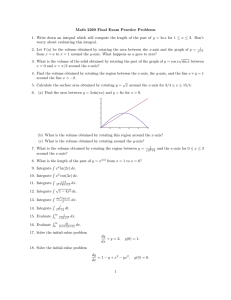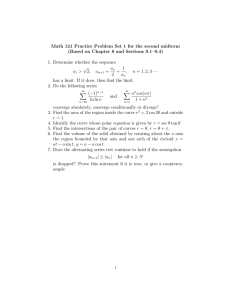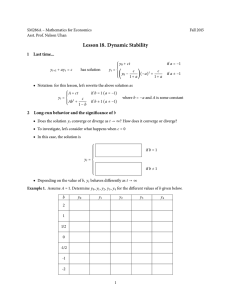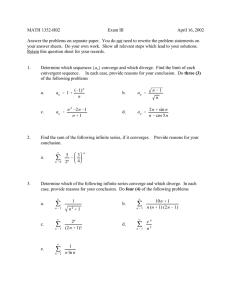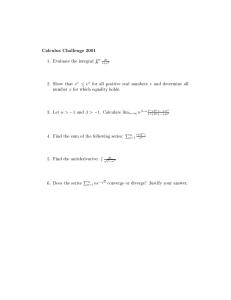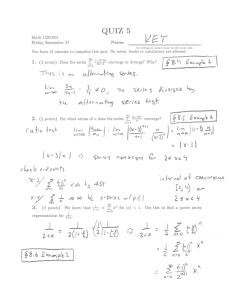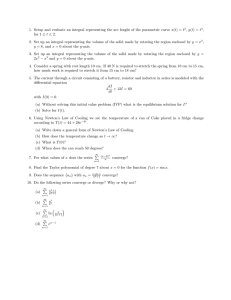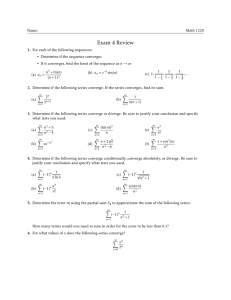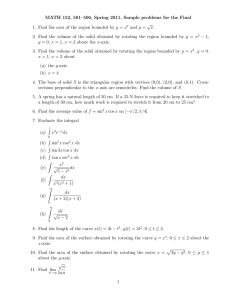Math 2260 Final Exam Practice Problems
advertisement
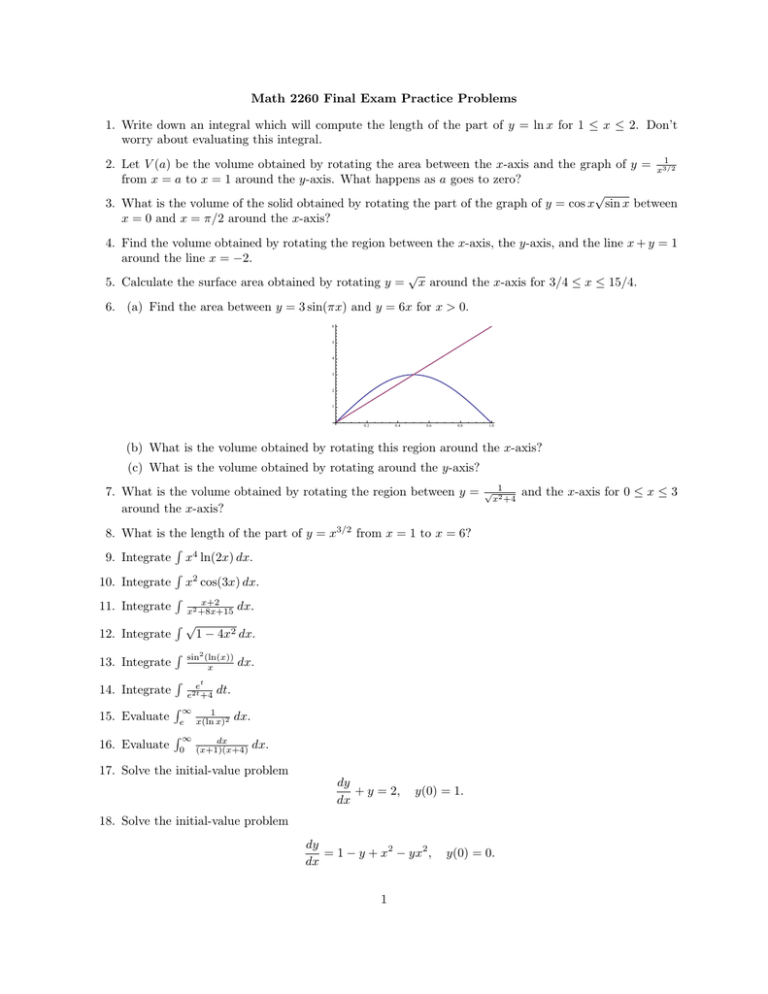
Math 2260 Final Exam Practice Problems 1. Write down an integral which will compute the length of the part of y = ln x for 1 ≤ x ≤ 2. Don’t worry about evaluating this integral. 1 2. Let V (a) be the volume obtained by rotating the area between the x-axis and the graph of y = x3/2 from x = a to x = 1 around the y-axis. What happens as a goes to zero? √ 3. What is the volume of the solid obtained by rotating the part of the graph of y = cos x sin x between x = 0 and x = π/2 around the x-axis? 4. Find the volume obtained by rotating the region between the x-axis, the y-axis, and the line x + y = 1 around the line x = −2. √ 5. Calculate the surface area obtained by rotating y = x around the x-axis for 3/4 ≤ x ≤ 15/4. 6. (a) Find the area between y = 3 sin(πx) and y = 6x for x > 0. 6 5 4 3 2 1 0.2 0.4 0.6 0.8 1.0 (b) What is the volume obtained by rotating this region around the x-axis? (c) What is the volume obtained by rotating around the y-axis? 7. What is the volume obtained by rotating the region between y = around the x-axis? √ 1 x2 +4 8. What is the length of the part of y = x3/2 from x = 1 to x = 6? R 9. Integrate x4 ln(2x) dx. R 10. Integrate x2 cos(3x) dx. R x+2 11. Integrate x2 +8x+15 dx. R√ 12. Integrate 1 − 4x2 dx. R 2 dx. 13. Integrate sin (ln(x)) x R t 14. Integrate e2te+4 dt. R∞ 15. Evaluate e x(ln1x)2 dx. R∞ dx 16. Evaluate 0 (x+1)(x+4) dx. 17. Solve the initial-value problem dy + y = 2, dx y(0) = 1. 18. Solve the initial-value problem dy = 1 − y + x2 − yx2 , dx 1 y(0) = 0. and the x-axis for 0 ≤ x ≤ 3 ∞ 19. Consider the sequence (an )n=1 , where an = ln(1 + 3/n) . sin(2/n) Does the sequence converge? If so, to what? If not, explain why. ∞ 20. Consider the sequence (an )n=1 , where an = n+1 n+2 n . Does the sequence converge? If so, to what? If not, explain why. 21. Which of the following series converge? P∞ n3 (a) n=1 3n P∞ n3 (b) n=1 1+n4 P∞ n3 (c) n=1 1+n5 P∞ cos2 n (d) n=1 1+e−n P ∞ en (e) n=1 n! 22. If you put (−1)n into each of the series in the preceding problem, which ones converge absolutely, which converge conditionally, and which diverge? 23. Does the series ∞ X (−1)n n(ln(n))2 n=2 converge absolutely, converge conditionally, or diverge? 24. Find the interval of convergence for each of the following power series. P∞ (x+2)n (a) n=1 n P∞ (x−3)n (b) n=1 1+n2 P∞ (−1)n (x−1)n (c) n=1 nen P∞ 2 n (d) n=1 n x 25. Find the Taylor series for 2 (a) e−x centered at x = 0 √ (b) x centered at x = 1 26. Estimate e−0.2 to the nearest 0.001. Explain your answer. 27. Does the series ∞ X n7 6n n! n=1 converge or diverge? Explain your answer. 2 28. Does the series ∞ X 1 √ n + n n=2 converge or diverge? Explain your answer. 29. Find the limit lim x→0 cos x − 1 . ex2 − 1 30. Give a geometric description of the set of points (x, y, z) satisfying the following inequalities. (a) x2 + y 2 + z 2 ≤ 1 and z ≥ 1/2. (b) |x| ≤ 1, |y| ≤ 1, and |z| ≤ 1. 31. Determine the angle between the vectors * * * * u = ı + 3 + 2k * 32. Write the vector * * * * * v = −2 ı + − 2 k and * * u = ı + + 5k * * * * * as the sum of two vectors, one parallel to v = −2 ı − − k and one perpendicular to v. 33. Find the area of the parallelogram spanned by the vectors * * * * u = −ı + − k and 3 * * * * v = 3 ı + 2 + k.
